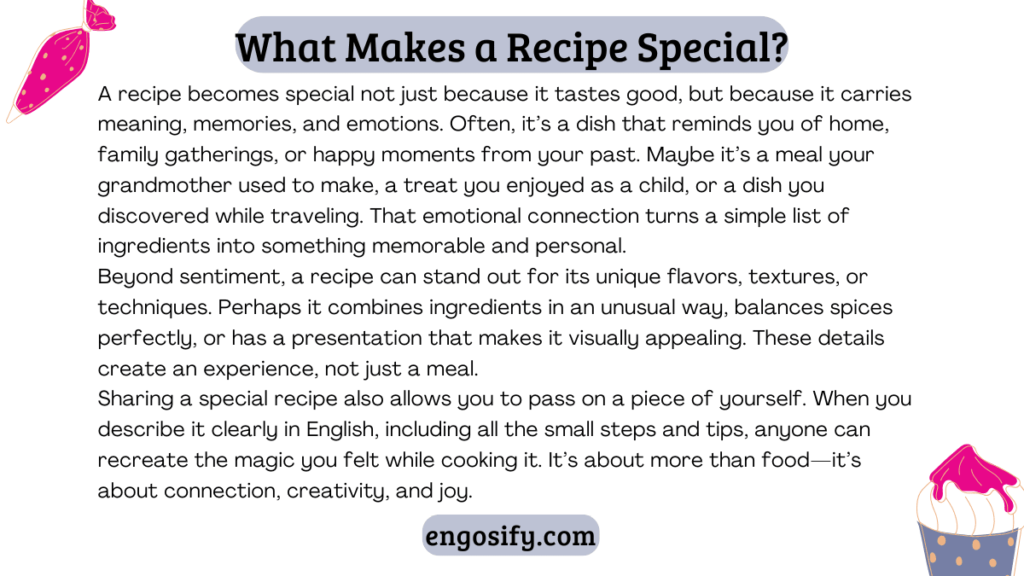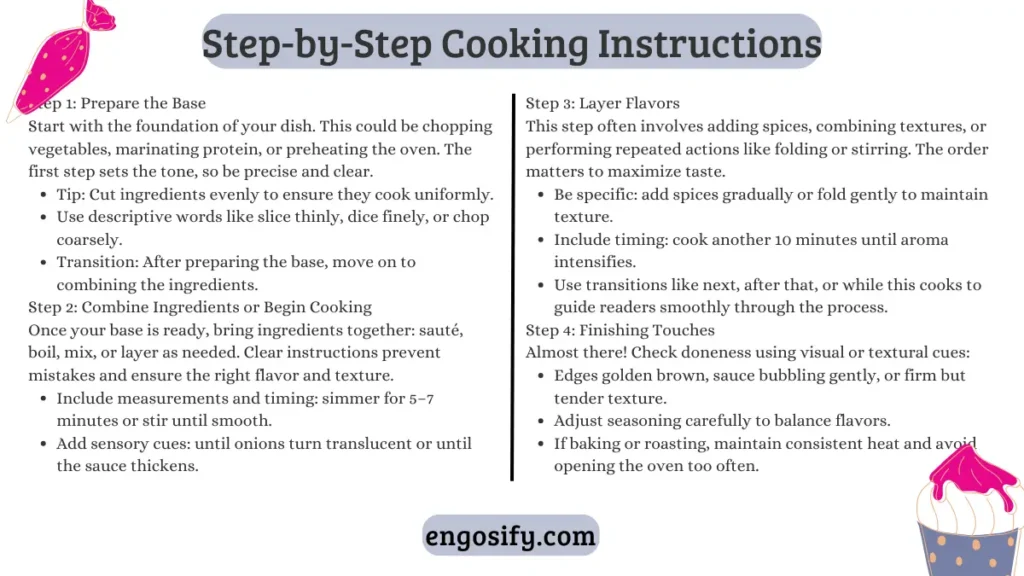Cooking can be one of the most delightful ways to express creativity, share love, and even relax after a busy day. Yet, nothing ruins the joy of making your favorite dish faster than unclear instructions or missing steps. In this article, we’ll explore how to describe Step-by-step recipe guide , ensuring anyone—beginners or seasoned cooks—can follow along without confusion. From preparing ingredients to serving the final dish, you’ll learn not only how to present a recipe clearly but also how to enhance the cooking experience for yourself and others. Let’s dive into the world of precise instructions and tasty outcomes!
Introduction
1.1 What Makes a Recipe Special?
Everyone has that one dish that brings back fond memories, fills the kitchen with irresistible aromas, and makes your taste buds dance. A special recipe often carries a story, whether it’s passed down from family, inspired by a childhood favorite, or discovered during travels. What sets your favorite recipe apart is not just its flavor but the emotional connection it creates. Sharing it with others allows you to pass on that joy, making cooking more than just preparing food—it becomes an experience.
Whether it’s the crispy edge of a golden-baked pie, the creamy texture of a homemade sauce, or the perfect balance of spices in a hearty stew, describing these elements clearly in English ensures anyone can replicate the magic. You want the reader to feel your excitement and picture the dish just from the instructions.
1.2 Importance of Clear Instructions
Imagine reading a recipe where the steps are vague, measurements are missing, or the cooking order is unclear—it’s frustrating, right? Clear instructions are the backbone of any good recipe. They:
- Ensure your dish turns out as intended.
- Prevent kitchen mishaps and wasted ingredients.
- Make cooking enjoyable rather than stressful.
By breaking the recipe into manageable steps, using precise language, and including helpful tips, you make the experience smooth and approachable. For example, The Spruce Eats guide highlights how reading through the recipe carefully before starting can save time and reduce confusion, allowing you to anticipate challenges and prepare accordingly.
Clear instructions also build confidence, especially for learners of English. Using simple, descriptive words, transition phrases like “next,” “after that,” or “while this cooks,” and emphasizing important points in italics helps convey steps efficiently. This approach not only teaches cooking but also strengthens language skills through context and application.

Preparing to Cook
2.1 Gathering Ingredients
Before you even think about turning on the stove, the first step is gathering all the ingredients. Nothing slows down cooking faster than realizing you’re missing half of what you need! Start by checking your recipe list carefully and making sure everything is fresh and measured correctly. Fresh ingredients not only improve the taste but also enhance the texture and color of your dish.
Tip: Wash, peel, chop, or measure ingredients before you start. This mise en place approach—French for “everything in its place”—keeps your workflow smooth and stress-free. For more guidance on preparing ingredients efficiently, you can check Sharon Palmer’s recipe writing tips.
Transition words like first, then, and after that are your best friends here because they help anyone following your instructions to move seamlessly from one task to the next.
2.2 Assembling Equipment
Next up is making sure your cooking tools are ready. Depending on your recipe, this could include mixing bowls, measuring spoons, cutting boards, blenders, or baking trays. Having everything within reach before you start saves time and prevents unnecessary frustration.
A quick check: ensure your oven is preheated if needed, your pans are clean, and any appliances are plugged in and ready to go. Even small details like lining a baking tray with parchment paper can make a huge difference in the final result. The Spruce Eats suggests setting up your workspace like a mini kitchen station—everything you’ll use in the next 10–15 minutes should be in easy reach.
2.3 Reading Through the Recipe
Before mixing or chopping, read the entire recipe carefully. This might sound obvious, but skipping this step often leads to mistakes. Identify special instructions, cooking times, and any tricky techniques that may require extra attention.
Understanding the recipe’s flow helps you plan and sequence your steps properly. For example, if the recipe calls for marinating, you know it must happen first, which can affect the timing of your other prep work. Using clear, descriptive words like gently fold, simmer until thick, or stir continuously gives learners and novice cooks confidence.
For tips on reading and interpreting recipes clearly, Virginia Tech’s extension guide provides excellent advice on ensuring that each step is understandable and actionable.
Step-by-Step Cooking Instructions
Cooking your favorite recipe is where the magic happens, but to get it right, every step must be clear and precise. Breaking down the process not only helps beginners follow along but also ensures that even seasoned cooks can replicate the dish perfectly. Let’s walk through the step-by-step instructions using simple English and helpful tips.
3.1 Step 1: [Start with the Base]
Begin by preparing the foundational elements of your recipe. Whether it’s chopping vegetables, marinating protein, or preheating the oven, the first step sets the tone for the entire dish.
- Tip: Always cut ingredients uniformly. Evenly sized pieces cook faster and look more appealing.
- Transition: After prepping, move on to combining the ingredients carefully.
For more insight on how to describe your first steps effectively, Allrecipes offers guidance on structuring your instructions so readers can follow without confusion.
3.2 Step 2: [Combine Ingredients or Begin Cooking]
Once the base is ready, it’s time to bring your ingredients together. This could mean mixing, sautéing, boiling, or layering flavors. Be specific:
- Use exact measurements and timing, like simmer for 5–7 minutes or stir until smooth.
- Include sensory cues, e.g., until onions turn translucent or the sauce thickens and coats the back of a spoon.
- Transition: While your mixture is cooking, you can prepare any additional components like garnishes or sides.
Precision in this step avoids overcooking or undercooking and ensures the final dish tastes just right. Refer to Virginia Tech’s guide for tips on clear, descriptive cooking instructions.
3.3 Step 3: [Intermediate Steps – Layering Flavors]
This stage usually involves adding spices, blending textures, or performing repeated actions like folding or stirring. Clear instructions here are crucial:
- Specify the order of adding ingredients, as it can affect flavor and consistency.
- Suggest techniques: fold gently to retain fluffiness, stir constantly to prevent burning.
- Include timing: cook for another 10 minutes until aroma intensifies.
Using words like next, after that, and while this cooks helps maintain a smooth flow for anyone following the recipe. For example, forum discussions on WordReference emphasize that the clarity of sequential steps can make or break the recipe for learners.

3.4 Step 4: [Finishing Touches in the Pan or Oven]
Almost there! This is where your dish starts looking like the one you envisioned.
- Check doneness with visual cues or texture, e.g., edges turn golden brown or sauce is bubbling gently.
- If baking or roasting, make sure the heat is consistent, and avoid opening the oven too frequently.
- Encourage tasting and adjusting seasoning carefully, so the flavors are balanced.
3.5 Step 5: [Plating or Transfer to Serving Dish]
Finally, your dish is ready to be served. Even if it tastes amazing, presentation adds that extra touch:
- Use a clean plate and arrange ingredients neatly.
- Garnish with herbs, a drizzle of sauce, or a sprinkle of spices for color and appeal.
- Remember, the final step is also part of the learning process—describe it clearly so readers can recreate the experience.
For more on crafting precise cooking instructions, check Allrecipes’ step-by-step guidance to see how pros structure each stage for clarity and success.
Part 3 covers the heart of cooking: transforming ingredients into a delicious meal with clear, descriptive steps. Next, in Part 4, we’ll discuss final touches, serving suggestions, and plating tips to make your dish not only tasty but also visually stunning.
Final Touches and Serving Suggestions
Once your dish is cooked, the final steps make it truly shine. These touches aren’t just about taste—they’re about creating an experience for anyone enjoying your recipe. From garnishing to pairing side dishes, these details take your cooking from good to unforgettable.
4.1 Garnishing and Plating
Presentation matters, even if you’re cooking for yourself! A few simple garnishes can elevate your dish:
- Fresh herbs, like parsley or cilantro, add color and a pop of flavor.
- Drizzle sauces or dressings strategically rather than pouring all over the plate.
- Arrange food neatly, balancing colors and textures to create a visually appealing plate.
Plating is also about portion control. Too much on the plate can look messy, while too little may seem uninviting. For creative ideas and practical tips on garnishing and plating, The Kitchn offers helpful advice.
4.2 Pairing with Side Dishes or Drinks
Even the best main dish shines brighter when paired with complementary sides. Consider:
- Seasonal vegetables, fresh salads, or simple grains that enhance the flavors.
- Light, non-alcoholic drinks like sparkling water with a splash of citrus or fruit-infused teas.
- Cultural pairings that complement the main dish’s origin, adding depth to the meal experience.
Using transition words like meanwhile, in addition, or alongside helps readers see how the main dish and sides come together smoothly. For inspiration on pairing ideas, check out Jenny Blogs’ guide to presenting dishes.
4.3 Storing Leftovers
Sometimes you have more than you can eat in one sitting. Proper storage ensures your food stays fresh and safe:
- Cool cooked food before refrigerating to avoid condensation, which can make it soggy.
- Store in airtight containers to maintain flavor and prevent contamination.
- Label containers with the date to keep track of freshness.
- Reheat gently to avoid drying out the dish, using low heat or a brief microwave session.
For more detailed tips on storing and preserving cooked dishes, BBC Good Food has an excellent guide.
FAQs
Can I substitute ingredients if I don’t have the originals?
- Absolutely! Use similar textures or flavors when possible. For example, if the recipe calls for brown sugar, you could use white sugar with a small drizzle of honey to add richness. Always mention substitutions in your recipe instructions so readers feel confident experimenting.
How do I know when the dish is done?
- Give sensory cues. Words like golden brown, bubbly, firm but tender, or aroma fills the kitchen help readers identify doneness without guesswork. Including a visual or textural indicator prevents undercooking or overcooking.
Can I make this recipe ahead of time?
- Yes, preparation ahead is possible for many recipes. Suggest steps for storing, such as refrigerating prepped ingredients or partially cooked components, and explain how to finish cooking later. This helps busy readers enjoy the dish without last-minute stress.
How can I adjust the recipe for more servings?
- Provide tips on scaling up ingredients proportionally and adjusting cooking times if necessary. Remind readers that some cooking steps, like browning or simmering, may require slight adjustments for larger batches.
What tools or techniques are essential for success?
- Highlight any tricky steps and explain techniques in simple language, such as fold gently to avoid deflating batter or simmer slowly for best flavor extraction. Linking to a tutorial or guide can be helpful, like The Spruce Eats’ detailed cooking instructions.
Conclusion
Cooking your favorite recipe is more than just following a list of ingredients—it’s about creating an experience that’s enjoyable, flavorful, and memorable. Clear, step-by-step instructions in English make it possible for anyone, whether a beginner or a seasoned cook, to replicate your dish with confidence. By preparing ingredients carefully, assembling your tools, and describing each step with precision and helpful tips, you ensure that the process is smooth, fun, and stress-free.
Remember, the magic of a recipe lies not only in the flavors but also in the presentation, the attention to detail, and the joy of sharing it with others. When you combine clear instructions with thoughtful garnishing, complementary sides, and proper storage, you transform cooking into an artful and rewarding experience.
Ultimately, describing your recipe clearly helps others enjoy your favorite dish just as much as you do—making the kitchen a place of creativity, learning, and delicious results.

